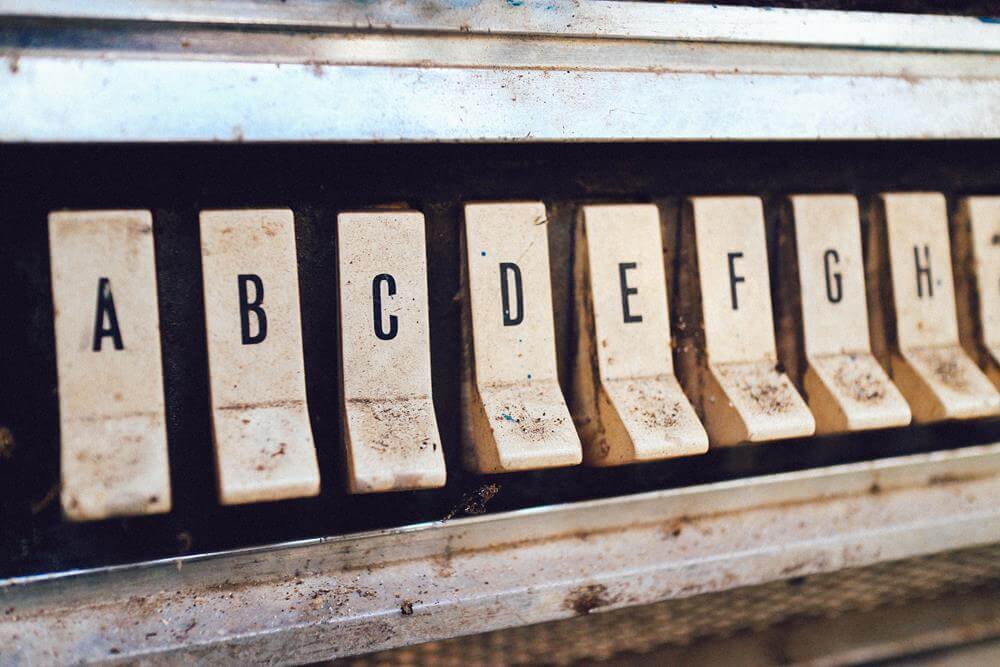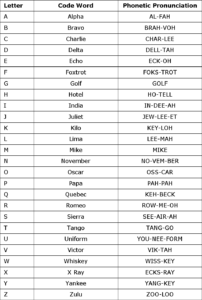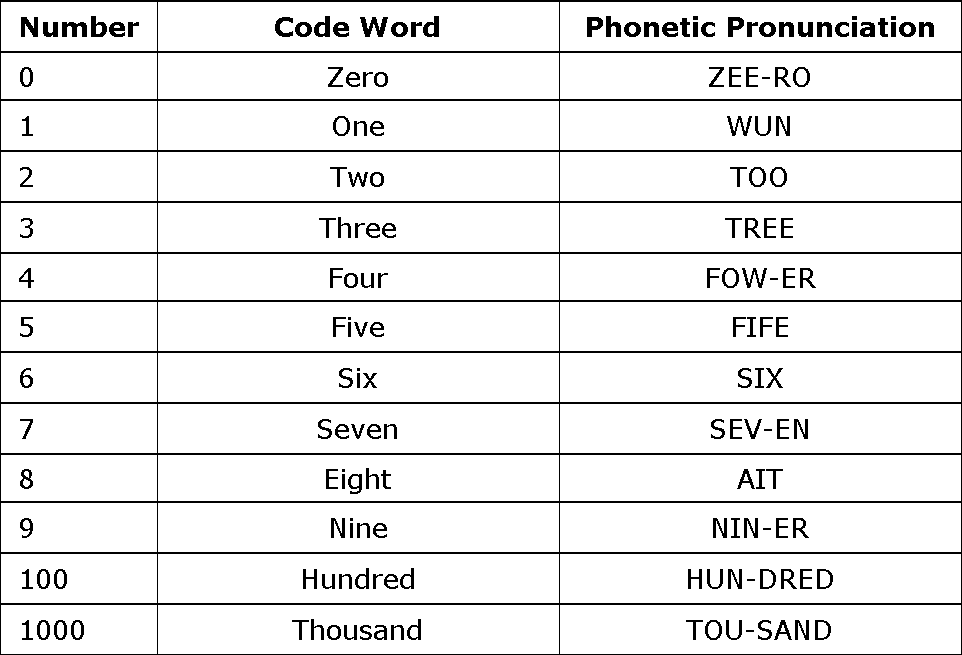
A phonetic alphabet is an alphabet in which each letter is represented by a codeword that starts with that letter. For example, in a phonetic alphabet, the letter ‘B’ could be represented by the word ‘Bravo’, while the letter ‘P’ could be represented by the word ‘Papa’.
The NATO phonetic alphabet, which uses a standardized set of codewords in order to refer to the letters in the English alphabet, is the most common type of phonetic alphabet in modern use. Phonetic alphabets in general, and the NATO phonetic alphabet in particular, are useful tools, since they can help you communicate more effectively in various situations. Furthermore, because the concept behind them is simple and intuitive, these alphabets can be learned quickly and easily.
As such, in the following article you will learn more about phonetic alphabets in general, and about the NATO phonetic alphabet in particular. Then, you will see tips on how to memorize the NATO phonetic alphabet, and understand how to use this type of alphabet in everyday situations, as effectively as possible.
How a phonetic alphabet works
To create a phonetic alphabet, you simply replace the letter that you want to say with a word that starts with the same letter, a concept which is called acrophony. For example:
- ‘C’ can be replaced by ‘Charlie’.
- ‘G’ can be replaced by ‘Golf’.
- ‘O’ can be replaced by ‘Oscar’.
Some phonetic alphabets use codewords that revolve around a specific theme; for example, several older alphabets used names of cities and countries as codewords (e.g. ‘Amsterdam’ and ‘Italy’). Other phonetic alphabets use codewords which are based on other factors, and most notably on intelligibility, which reflects how easy the codewords are to understand in conditions where it’s difficult to communicate (e.g. ‘Able’ and ‘Baker’).
Note: ‘phonetic alphabet’ is a colloquial term used to refer to spelling alphabets, which are also referred to using other terms, such as word-spelling alphabets, radio alphabets or telephone alphabets. In addition, note that such alphabets are unrelated to phonetic notation and transcription systems, such as the International Phonetic Alphabet, which uses symbols in order to create a visual representation of sounds that appear in spoken languages.
Why use a phonetic alphabet
Miscommunication issues can occur due to a variety of reasons, such as because you have bad reception on your phone, because you’re talking in an area with a lot of background noise, or because you’re talking to someone who has a strong accent that you’re not used to. Such issues are especially frustrating and problematic if you’re trying to communicate an exact term, such as a name, a street address, or a serial number.
Phonetic alphabets can facilitate communication in such situations, and reduce the likelihood of miscommunication issues, by helping you spell out exact terms in a way which is intelligible to listeners regardless of the circumstances. This can be valuable, for example, if you’re talking to tech support, or if you’re giving critical information to emergency services. In fact, the NATO alphabet is so effective that there have been calls for using it among medical professionals, where accurate communication can be a matter of life and death.
The NATO phonetic alphabet
The NATO phonetic alphabet is a widely-used, standardized phonetic alphabet, where each letter in the English alphabet is replaced with a specific, specially-chosen codeword
The NATO phonetic alphabet was formally established in 1956 through the joint effort of several groups, including, most notably, the North Atlantic Treaty Organization (NATO) and the International Civil Aviation Organization (ICAO). It was created with the goal of becoming the universal phonetic alphabet, in order to overcome the issues which occurred as a result of different countries and organizations using different alphabets.
There are two main advantages to learning the NATO phonetic alphabet today compared to other alphabets:
- The NATO alphabet is the main phonetic alphabet used by many countries, organizations, and individuals around the world, meaning that a lot of people, and especially those who encounter it in a professional setting, are likely to be familiar with it. Accordingly, this is the phonetic alphabet that people are most likely to easily understand if you use it to talk to them, and it’s also the phonetic alphabet that people are most likely to use when talking to you.
- The specific codewords in the NATO phonetic alphabet were chosen based on extensive testing, as they ensure mutual intelligibility between speakers from different linguistic backgrounds, by virtue of being easy to pronounce and recognize.
Accordingly, the NATO phonetic alphabet consists of 26 codewords, each of which represents a different letter of the English alphabet. These words are:
Alfa, Bravo, Charlie, Delta, Echo, Foxtrot, Golf, Hotel, India, Juliett, Kilo, Lima, Mike, November, Oscar, Papa, Quebec, Romeo, Sierra, Tango, Uniform, Victor, Whiskey, X-ray, Yankee, Zulu.
For example, using the NATO phonetic alphabet, you would spell the word ‘positive’ in the following manner:
Positive: Papa, Oscar, Sierra, India, Tango, India, Victor, Echo.
In the image below, you can see the full NATO phonetic alphabet, which shows which letter each codeword signifies, together with the official phonetic pronunciation of that codeword.

If you want to say a number in the NATO alphabet, you generally pronounce the number as you would normally, though there are a few minor variations in pronunciation in some cases, compared to the way you would pronounce the name of the number in conventional English, as shown below:

In the NATO alphabet, punctuation marks are referred to by their name, with a few exceptions: a hyphen (-) is referred to as a dash, a period (.) is referred to as a stop, and a decimal point is referred to as a point or as a decimal.
If you would like a full table of the NATO phonetic alphabet, which contains both the letters and the numbers, you can view it in the following links either as an image or as a PDF.
Note: the NATO phonetic alphabet is also referred to using other terms, including the ICAO radiotelephony alphabet, the ICAO phonetic alphabet, the international radiotelephony spelling alphabet, the military phonetic alphabet, the military alphabet, or just the phonetic alphabet.
How to learn the NATO phonetic alphabet
Since the NATO alphabet contains only a small number of items, and since it’s fairly intuitive by design, it should be relatively easy to memorize it with some practice.
If you decide you want to learn the NATO phonetic alphabet, you can do it using a variety of methods, such as by writing down the codewords on handmade flashcards, or by using a memorization software. You could also choose to simply memorize the codewords in order, using a list of the codewords in the NATO phonetic alphabet. Potentially, you can recite these words with a rhythm or tune that makes the codewords easier for you to remember, though this isn’t crucial.
If you’re struggling to remember specific codewords, you can try to associate them with whatever they represent. For example, if you struggle to remember that the codeword for the letter “W” is “Whiskey”, try to not just focus on memorizing the codeword itself, but also on remembering a relevant image that is associated with it, such as a bottle of whiskey.
Once you can roughly recall all the codewords, start practicing the use of the alphabet by spelling out various words with it. These words can be anything you want: from random items you see, to the addresses of streets that you pass.
Finally, note that if you end up forgetting a certain keyword while using the NATO phonetic alphabet in real time, you can improvise and use an alternative codeword, which starts with the same letter as the codeword that you’re trying to communicate. Because people who use the NATO phonetic alphabet generally understand the underlying concept behind it, they will usually be able to understand what information you’re trying to convey when you do so, and as such you should be able to reliably use the NATO phonetic alphabet even if you don’t remember it with 100% accuracy.
Tips for using the NATO phonetic alphabet
There are a few things you should keep in mind when using the NATO alphabet, in order to ensure that you’re using it as effectively as possible:
- Make sure that the person you’re talking to knows that you are spelling out words using the NATO phonetic alphabet, before you start doing so.
- If the person that you’re talking to is not familiar with the concept of the phonetic alphabet, you can use the following pattern of speech when spelling out words: “S as in Sierra, N as in November…”, which most people will intuitively understand.
- In some cases, you might benefit from saying the full term that you’re referencing before you start spelling it using the phonetic alphabet. This can help, for example, in situations where the other person might be able to figure out what you’re trying to spell when you’re halfway through the term.
Tips for improvising a phonetic alphabet
If you’re improvising a full phonetic alphabet or some specific codewords in cases where you can’t remember which ones are used in the NATO phonetic alphabet, then the following tips can help you pick good codewords to use:
- Pick a word that most people will be familiar with.
- Pick a medium-length word, with about two syllables (e.g. ‘Oscar’, which is pronounced ‘OS-CAR’).
- Avoid words that can be easily confused with other words, especially due to a similar-sounding initial letter (e.g. ‘Ban’/’Pan’).
- Avoid words that contain an initial letter that is difficult to isolate (e.g. the ‘T’ in ‘Trail’, which is followed immediately by an ‘R’). Accordingly, if the letter that you are trying to spell out is a consonant, then the letter which follows it should be a vowel, as in the case of ‘Kilo’, for example, where the ‘K’ is followed by an ‘I’. Conversely, if the letter that you are trying to spell out is a vowel, then the letter which follows it should be a consonant; for example, in ‘Alfa’, the ‘A’ is followed by an ‘L’.
These tips are reflected, for the most part, in the codewords which are used in the NATO phonetic alphabet. There are some exceptions to this; for example, in the codeword ‘Bravo’, the initial ‘B’ is followed immediately by an ‘R’. However, even such exceptions tend to still adhere to the overall guidelines for picking codewords, and in this case, for example, there is a strong phonetic contrast between the two sounds (‘B’ and ‘R’), which makes them relatively easy to tell apart.
Finally, note that, while these tips are beneficial, they’re not crucial for the most part, and the most important thing is to simply pick a word that people will be able to clearly identify. Furthermore, remember that if you have any doubts as to whether you were properly understood, you can ask the other person to repeat what you said to them after you finish talking. Then, if you notice any miscommunication issues, you can adjust the codewords that you used accordingly, and repeat the problematic parts of your message.
Summary and conclusions
- A phonetic alphabet is an alphabet in which each letter is represented by a codeword that starts with that letter. For example, in a phonetic alphabet, the letter ‘B’ could be represented by the word ‘Bravo’.
- Phonetic alphabets are used in order to avoid miscommunication issues, by allowing you to spell out exact terms in a way that is intelligible in problematic situations, such as in situations where there is a lot of background noise or in situations where you’re trying to communicate with someone who has a markedly different accent than you.
- The NATO phonetic alphabet is a commonly used alphabet, which was established in order to create a standardized system of communication across the world, based on codewords that were selected in order to ensure intelligibility.
- When using a phonetic alphabet, it’s generally preferable to use codewords from the NATO alphabet, though you can also improvise codewords which are based on the same principles in situations where you can’t remember which NATO codeword to use.
- Before you start using a phonetic alphabet in order to communicate with someone, you should make sure that the person that you’re talking to understands what you’re about to do; if they’re not familiar with the concept of phonetic alphabets, you can use the following formulation, which most people will intuitively understand: “M as in Mike, E as in Echo…”.